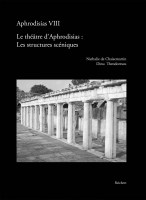Search
Chaisemartin, Nathalie; Theodorescu, Dinu
Goubin; Lemaire
Le théâtre d’Aphrodisias: Les structures scéniques
2017
23.0 x 31.0 cm, 368 p., 3 illustrations color, 481 illustrations b/w, 3 Faltpläne, hard cover with dust jacket
ISBN: 9783954901128
go to ebook version
23.0 x 31.0 cm, 368 p., 3 illustrations color, 481 illustrations b/w, 3 Faltpläne, hard cover with dust jacket
79,00 €
ISBN: 9783954901128
go to ebook version
Short Description
The book is dedicated to the Theatre building at Aphrodisias and in particular its stage building. Dated by its two inscriptions between 30 and 27 BC, the theatre’s original stage building stood until its collapse in the seventh century and almost all of the elements of the stage façade were conserved by its transformation into a Byzantine fort. The volume presents a restoration made from long years of study of the architectural elements. The study is of value to architectural development in the Greco-Roman world and reflects patterns in urban development from the Hellenistic to the Byzantine periods.Description
The book is the full publication of the stage structures of the theatre in the Carian city of Aphrodisias. Dedicated by C. Julius Zoilos, freedman of Octavian, between 30 and 27 BC, the theatre’s original stage building was preserved unmodified until its collapse in the seventh century. Almost all of the elements of the stage façade were buried under a Byzantine fort and the modern village of Geyre, until the excavations of Prof. K.Erim in 1964-1971. No other theatre stage façade of the first century BC is preserved in the Mediterranean world. The book begins with an architectural analysis of the theatre’s main structures: a semicircular auditorium, divided into 11 cunei, an arena surrounded by a podium, a marble-paved stage floor resting on a pulpitum-wall and a rectangular stage building fronted in the west by a Doric portico. In 1988 and 1989 several sondages around the stage building and in the arena confirmed the chronology of the monument’s phases which J.M. Reynolds had established on the basis of epigraphic evidence. In the middle imperial period, the theatre was progressively transformed to accommodate gladiatorial games and wild beast hunts. The recording of all the architectural elements permitted a full restoration of the stage façade, its innovative design, and its original decoration. Contemporary with the treatise of Vitruvius, the Aphrodisias theatre allows a more precise evaluation of the relationship between Greek and Roman theatre designs.Biographical Note
Nathalie de Chaisemartin1969 Master of arts in Archeology of the Roman World, Paris -Sorbonne University.
PhD of classical Archaeology
1970-1986 Lecturer and assistant professor for french Litterature, civilisation and History of Art
1987- 1999: Assistant-professor in classical Archaeology and History of Art of the Antiquity, Michel de Montaigne- Bordeaux III University
1999 -2012: Assistant-professor in classical Archaeology and History of Art of the roman world, Paris-Sorbonne University,




 Preface
Preface

 Neuerscheinungen 2023/2024
Neuerscheinungen 2023/2024
 Gesamtverzeichnis 2023/2024
Gesamtverzeichnis 2023/2024
 Katalog Oriental Studies & Linguistics
Katalog Oriental Studies & Linguistics
 Mittelalter
Mittelalter
 Deutsche Inschriften
Deutsche Inschriften
 Musiktherapie
Musiktherapie
 Literaturen im Kontext
Literaturen im Kontext